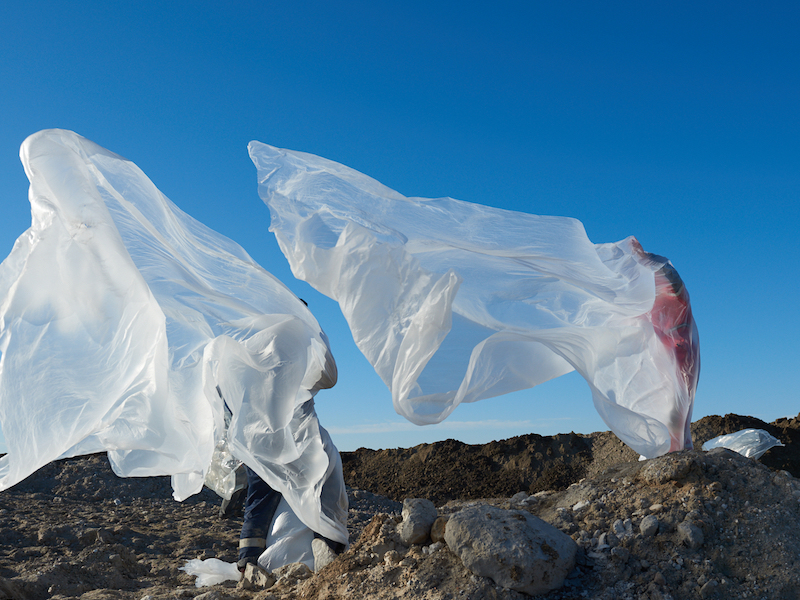
“...our bodies always extend and connect to other bodies, human and non-human, to practices, techniques, technologies and objects which produce different kinds of bodies and different ways, arguably, of enacting what it means to be human. The idea of the body as simply something we both have and are is displaced in this perspective as the focus shifts to what bodies can do, what bodies could become, what practices enable and coordinate the doing of particular kinds of bodies, and what this makes possible in terms of our approach to questions about life, humanness, culture, power, technology and subjectivity. These are some of the themes.... which radically refigure the idea of the body as substance or entity and even as distinctly human.” Lisa Blackman, The Body
Nana Francisca Schottländer is a Copenhagen-based cross disciplinary artist working in the intersection between dance, performance, installation- and conceptual art. Central to her work is the use of her own body as a living tool for research and creation. Since 2016 her focus has been on the co-creational potentials of encounters and intra-actions between humans and other-than-humans such as wind, fungi, tide, rocks, soil and entire geographical areas with their inherent phenomena and beings — in more recent years focusing on landscapes marked by human intervention such as mining, quarrying, relocation of soil as well as (post)industrial and urban landscapes. Her works are conceptualized site-specifically and employ strategies of immersion, co-creation and long duration, deeply rooted in both theory, literature, locational awareness and personal experience and often forming part of serial explorations of particular themes. |
In the series Heavy Kinship she explores the co-creative potentials of encounters between rocks and humans; between stony and fleshy bodies. Asking: what does it take to engage in respectful, reciprocal and intimate exchanges with something existing on such radically different terms than ourselves as rocks and stones? How do we step beyond the instrumentalization of other-than-human beings, matters and resources to create genuinely respectful encounters between entities? Within the IN SITU program of (UN)COMMON SPACES, Nana Francisca Schottländer has explored a series of European landscapes marked by human intervention, focusing on the mutually shaping dynamics between bodies of rock, of flesh and of water, as they collide and move through time - ancient and recent - and space - local and global. The working title for this research is ROCK, FLESH, WATER - stages of fluidity and notions of time Based on this, she was invited by La Strada to partake in their longterm project ‘Signal am Dachstein’ and visit the Dachstein massif and the rapidly melting glacier on it. This is her account of this journey. |
Traveling and thinking of you I’m on my way, traveling to you. Slowly, by train so as to not heap more heat on your melting shoulders. Trying to imagine what our first encounter will be like. Trying to imagine you, resting there in the lap of a mountain that rises and crumbles at the same time. Coming undone after thousands of years of making yourself hard. Seeping, slipping, sliding and disappearing. The transition has begun, is an irreversible fact. And something about this transition from hard to soft, from firm to fluid is resonating deep within in me. Although I know it is the end of you, it is also the beginning of something new. I am both filled with sorrow and a sense of loss, but also full of hope, hope that in your fluid transition you can teach me something about becoming soft. Teach me something about embracing change. Teach me something about shifting, moving on. I will grieve your death, sing a lament, let my naked body bond with you, carry you with me in my heart and in the fluids of my flesh. And I will honor your memory by celebrating our future. A future I can barely glimpse through the dystopian haze of my time. A future I will into existence by looking at the past long, slow transitions that we have always been part of. Slipping, seeping, sliding into that future with you… |
 | Arrival We (Susanne, Werner, Christiane and I) arrive in the evening in the tiny historic city of Hallstatt, and eat our dinner overlooking a huge lake, all surrounded by mountains. I feel as if I’m in a fairytale as I fall asleep in the old inn amongst the traditional decor…
|
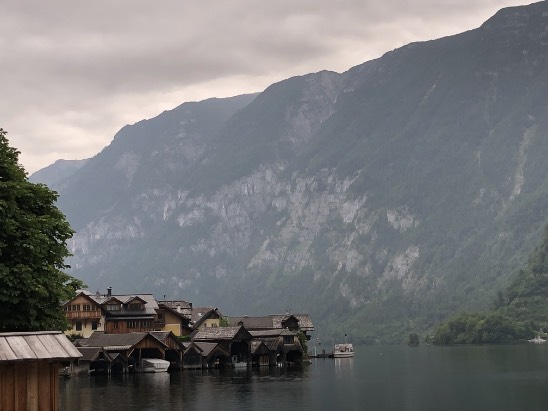 | |
| The next morning, early, we begin our ascent. Following a river upstream through lush woods | 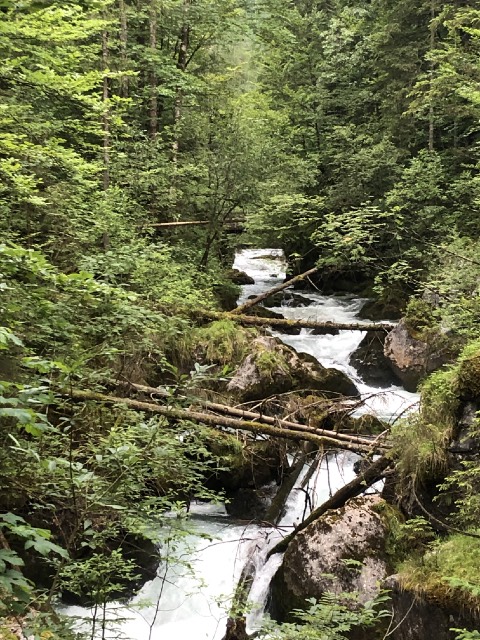 |  |
I get so excited as we discover and try to name the different plants in German, Danish and English, sharing our knowledge of their properties and finding common ground in unfamiliar circumstances. I have never climbed a mountain before. I keep getting seduced by the immense detail of the rocks, trees, plants and waters — How the waters hurl downstream in falls and pools |  |
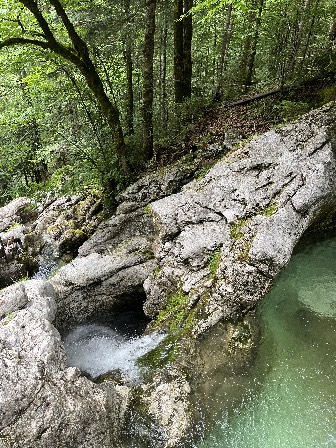 | 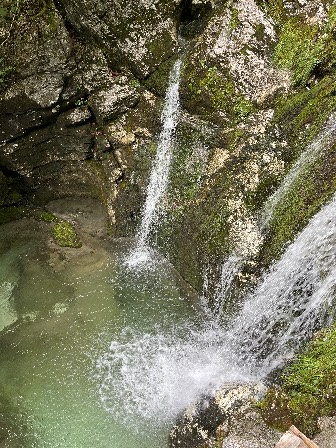 |
 | How dead bodies of ancient sea animals have left imprints in the rocks and how their red mineral colors look almost like their blood, still seeping, through aeons. | 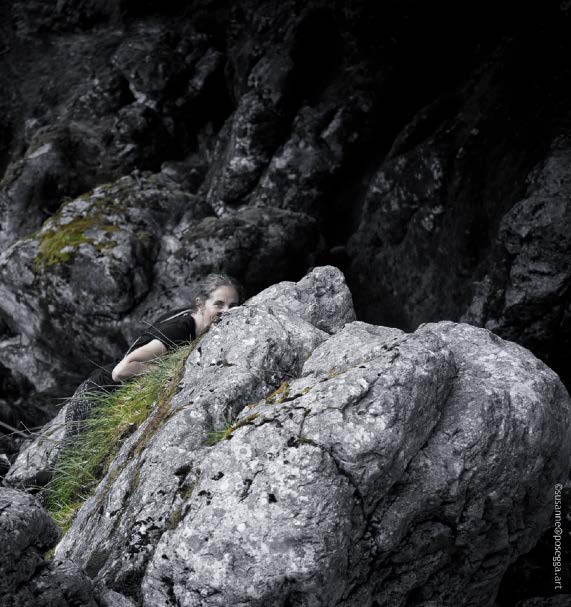 |
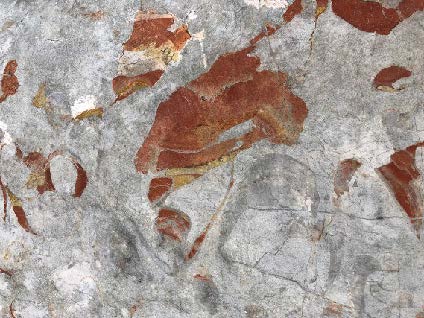 | 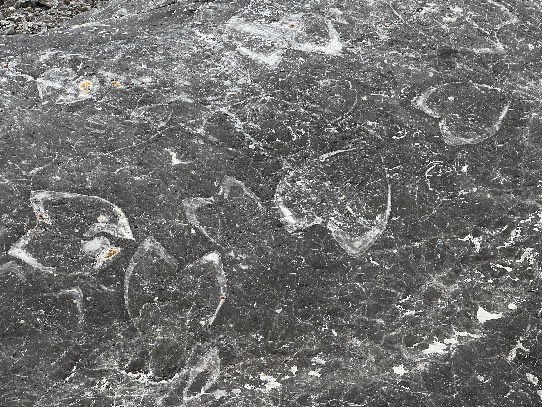 |
How roots of fallen trees have torn away topsoil and moss to expose the pure, soft pinkish hues of the rocks, resting there, like ancient bodies, honed — maybe caressed — by ice and water through eternities. Soft organs exposed. Inviting intimacy and encounters between human bodies and mountainous bodies. And, and, and… |  | |
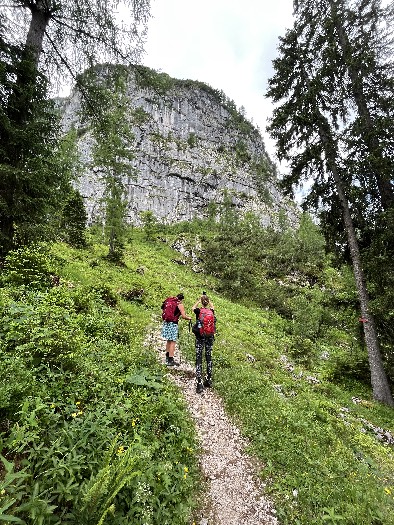 | 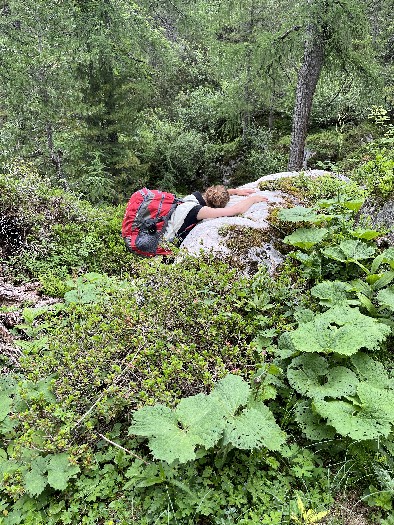 | |
But we must move on. We have a destination, a plan, and a path to follow.
We walk two thirds of the route. With heavy bags on our backs we move up, up, up through lush mountain gardens filled with magical butterflies fluttering over green, juicy leaves adorning themselves with dewdrops while metallic blue beetles gnaw their leaves into intricate lace patterns.
I steel moments to pause and allow my amazement. In danish one word for amazed is ‘bjergtaget’, literally translating into ‘being taken by the mountain’. | 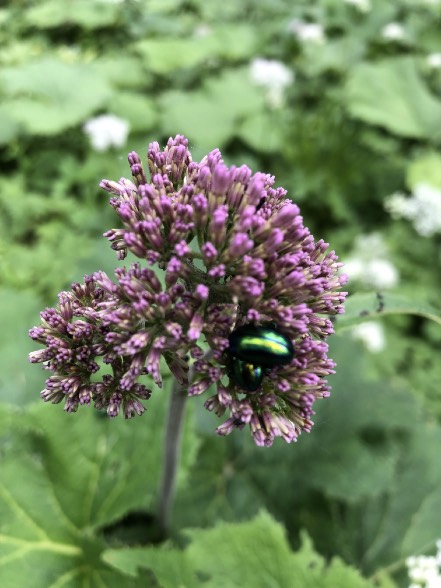 |  |
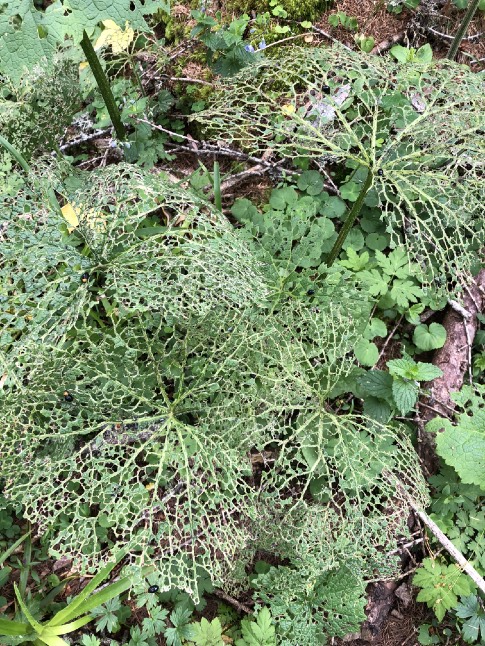 |  |
Susanne Posegga, our mountain guide and photographer, tells me: “there are lakes and rivers inside the mountain” This keeps echoing in my mind |  |
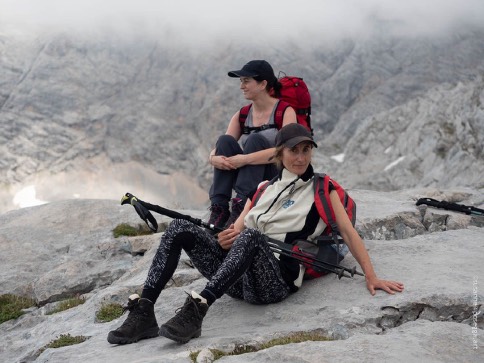 |
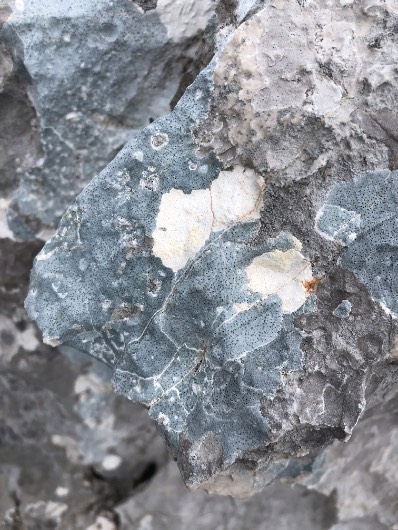 | As we get higher, the vegetation gets sparser, only low bushes and shrubs. And gradually the lushness is replaced by myriad nuances of grey and pink in the rocks and the blue, green, grey of lichen growing on them. | 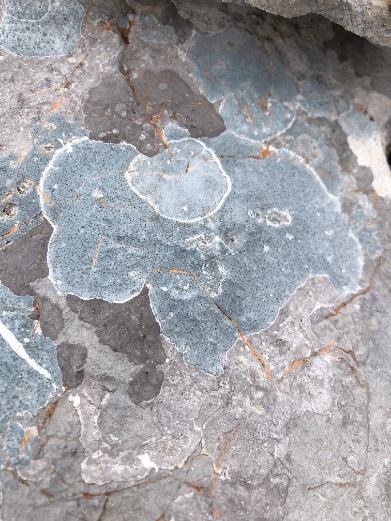 |
Unmelted, icy patches of snow rest in the recesses, their surfaces stuck in wavy patterns accentuated by a thin layer of grey fallout from the plane-filled atmosphere. The rim of each patch of snow follows the rocky terrain perfectly as heat from the sun is absorbed by the rocks that melt the snow into an exact counter-image. This transition between snow/ice and rock fascinates me endlessly, and I feel such a strong urge to place my own soft, warm body there to take part in the layering and reciprocal shaping processes that take place here. But we are running out of time and daylight. No time for intimacy… |  | |
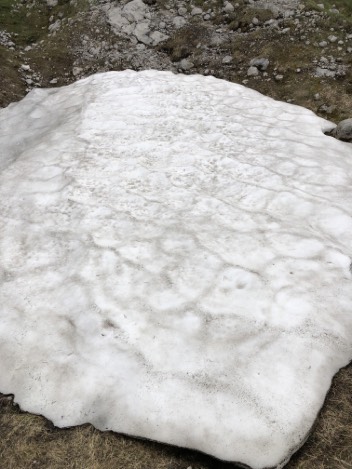 | 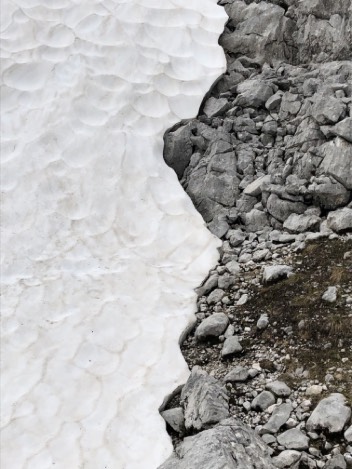 |  |
As we reach Simonihüttel, where we will spend the night, grey clouds are building over the glacier resting above us on the mountain in the distance. No improvised fooling around with naked bodies in a place like this… |  |
Going Visiting “Visiting is not an easy practice; it demands the ability to find others actively interesting, even, or especially others most people already claim to know all too completely, to ask questions that one's interlocutors truly find interesting, to cultivate the wild virtue of curiosity, to attune one's ability to sense and respond - and to do all this politely!” […] “[This] sort of politeness does the energetic work of holding open the possibility that surprises are in store, that something interesting is about to happen, but only if one cultivates the virtue of letting those, one visits intra-actively shape what occurs. They are not who/what we expected to visit, and we are not who/what we anticipated either. Visiting is a subject- and object-making dance, and the choreographer is a trickster.” (Donna J. Haraway, Staying with the Trouble - Making Kin in the Chthulucene) | |
Visiting a glacier The next day our glacier guide arrives. Seasoned. Weathered. Slim, sinewy and big-booted. Both in a symbiotic relationship with the landscapes and un-stirred about the rapid changes occuring. The world changes. It was ever so. I guess he is right… We venture into the barren landscape exposed by the melting glacier. Below us bright turquoise pools of meltwater puncture the expanses. Above us the glacial body rests in |  |
 |  |
Nothing grows here yet. Not even the lichen have settled in. Pristine in all its nakedness. It feels like moving through the beginning of the world. Or maybe it’s the end? The rocks tell their ancient tales in grey and pinkish hues, relate their oceanic origins and ice-worn heritage and wait for life to appear, slowly, now that the ice has receded. My feet seem to understand the rocks; they invite me and I almost feel as though I float up their steep surfaces. Exposed, softly honed bodies, accepting my presence here in all my excited smallness. They resonate so deeply in me. As if this place always existed inside. | 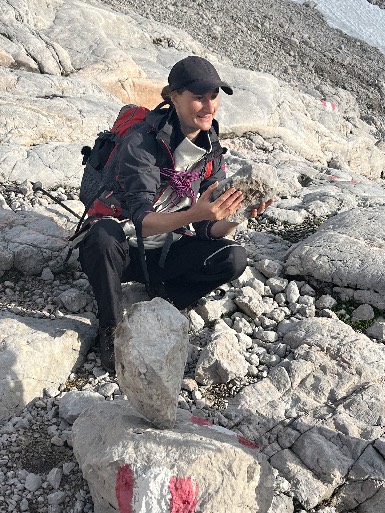 |
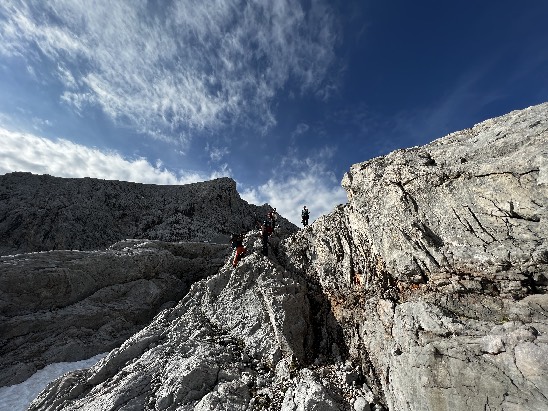 | |
We reach larger patches of snow. Tie ourselves together with a long rope and venture onto the blue-grey glacier flats, gurgling and rushing both above and below the ice. The first place we try to enter is too dangerous. We proceed along the rim of the melting body. And then we enter. I have to stop, have to feel this giant body of ice below me.  | 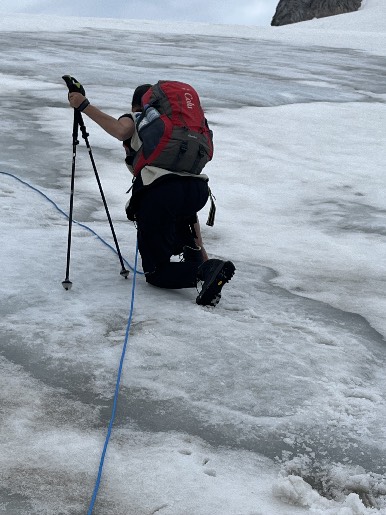 | 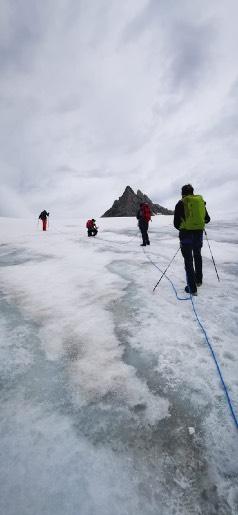 |
 |
And this strange, bubbly, melting, excited love overwhelms me. This is only our first encounter. And it is so brief. But it moves me deeply. And I want to move with it. Dance in honor of the mountainous embrace and the trembling, blue body melting in it. I ask the glacier if it’s sad about melting. And to my surprise the gushing, melting waters only answer in pure excitement about their imminent journey into the world. They don’t grieve the speeding transformation/destruction. But I do. Should I…?We continue. Placing our feet in the footsteps of the person in front of us. Surrounded by the sound of the melting waters rushing into the world. As we approach the top of the glacier and the roof of the mountain, the landscape shifts: the slopes have been prepared for people to go skiing and walking and we glimpse a towering steel construction. The clouds keep building in the sky, and we discuss the safety of continuing on our planned route if a thunderstorm breaks out. We are an easy target for lightning with our small, erect bodies atop the mountain. And so we decide to abort the planned route down the other side of the mountain, enter the tourist zone and take the cable car down. | 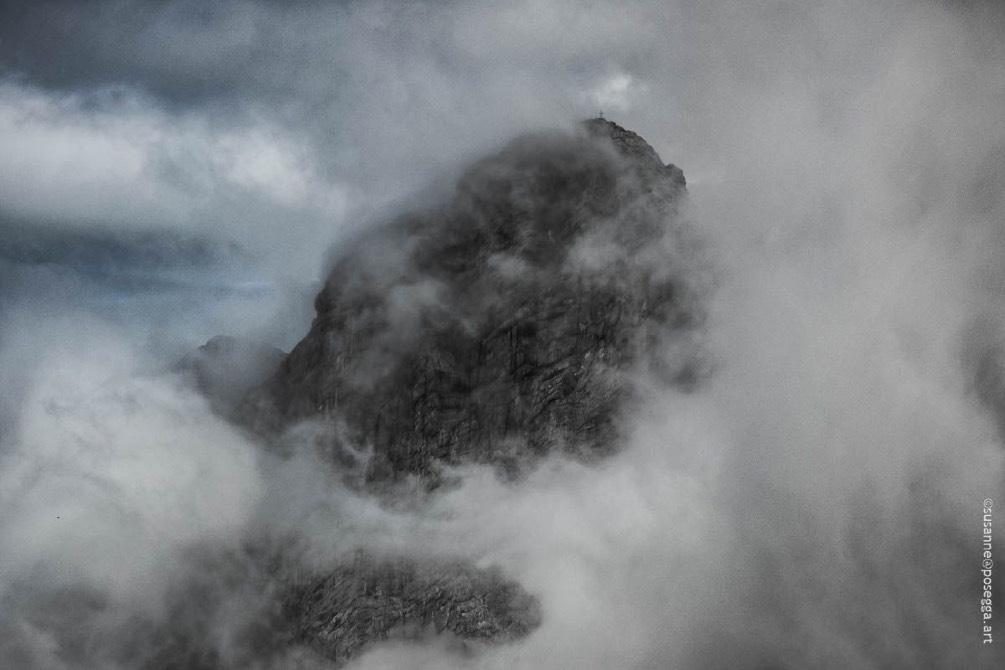 |
Extractive tourism We take off our ropes and share a moment, moved to tears to have witnessed this barren, seemingly untouched landscape together. And then we enter the habitat of tourism. On top of the mountain a giant metal construction marks the end point of the cable car which daily brings approximately 3000 people from all over the world up in around 7 minutes so they can walk on the glacier and drink a cup of coffee in the cafeteria overlooking the icy slopes, the pointy roof-rock (Dachstein) and the valley deep below before going back down and traveling on to other exciting destinations. | 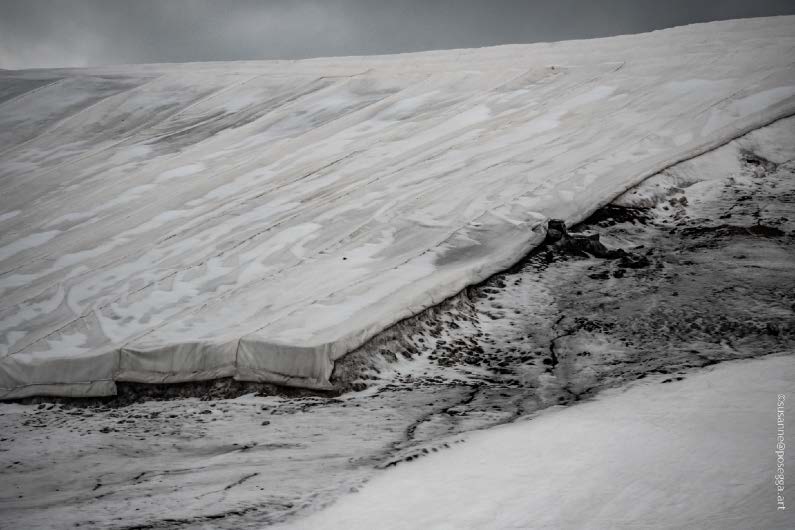 | |
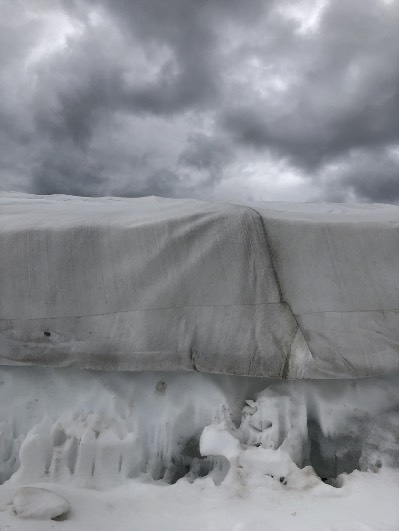 | 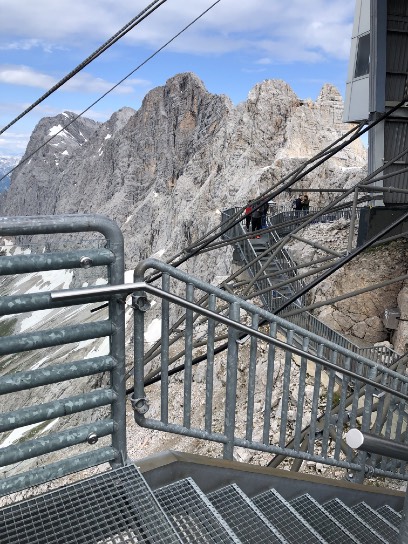 | 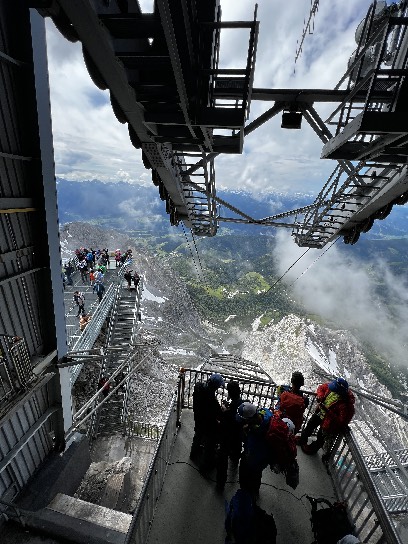 |
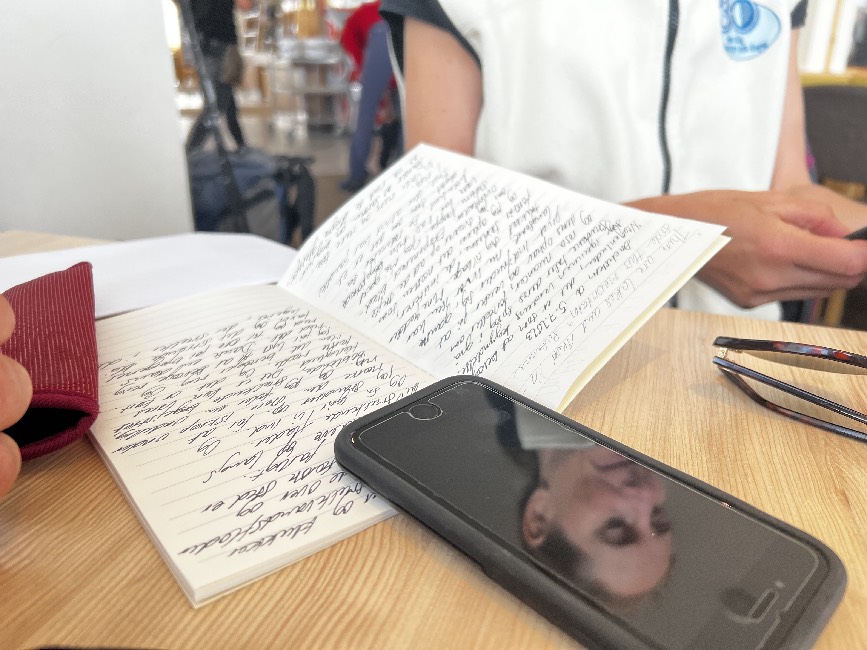 | In several places the icy surfaces have been covered with large white tarpaulins to prevent the heat from the sun melting the ashy grey surfaces of the glacier, polluted by fallout from air traffic and other carbon-based industries . It’s not to protect the glacier, but to maintain the sub-glacial ice-palace, that has been constructed to entertain the tourists who line up to enter. All of this is in such horrible and surreal contrast to our laborious, excited and humble ascent through the newly exposed landscapes and over the living, moving glacier. The extractive nature of the tourism industry becomes so obvious. And so paradoxical: because of the vast numbers of people from all over the world flying here every day to visit the glacier, the glacier is melting. The unfathomable stupidity of our modern consumption… To hold on to the resonances of my encounter with the mountain I escape into my notebook as we sit in the café with all the other tourists. And then we take the cablecar and go down in merely 7 minutes… And it just feels wrong. |
We have lunch at the bottom of the cable car, and fortunately we can walk down the last part of the mountain to reconnect with the bubbly joy of greenness, smells, nuances and growth before arriving in the city of Schladming where we are booked into a generic tourist hotel |  |  |
 |
***
Every time I am by myself, I start crying again. But it’s not grief. It’s love. Maybe I’m beginning to melt. Like you…
***
From the end of the bed my generic hotel room in tourist-infected Schladming I have a partial view of the mountain - and the thunderstorm, which arrived much later than anticipated. So I place myself there, full of longing to go back up. Up to the strange, newborn land, which is neither the beginning nor the end but both at the same time, which makes it so incredibly touching.
In the evening the rain is pouring hard as we have dinner and I a video photographer who is also part of the Signal am Dachstein project and who will join us the next day as we go back up the mountain to visit Bodo Hell, a 80-year old Viennese poet who has spent his summers there the last 40 years tending to the cattle that come to graze high up in the mountains for 2 months every summer before they go back to the lowlands.
Sea of green
The next day we go up, up, up again, and arrive to Bodos dwelling in this otherworldly, green, hilly land. So very different from the rest of the mountain. Shaped through hundreds of years of grazing, shitting cattle, that have gradually formed the land and the vegetation.
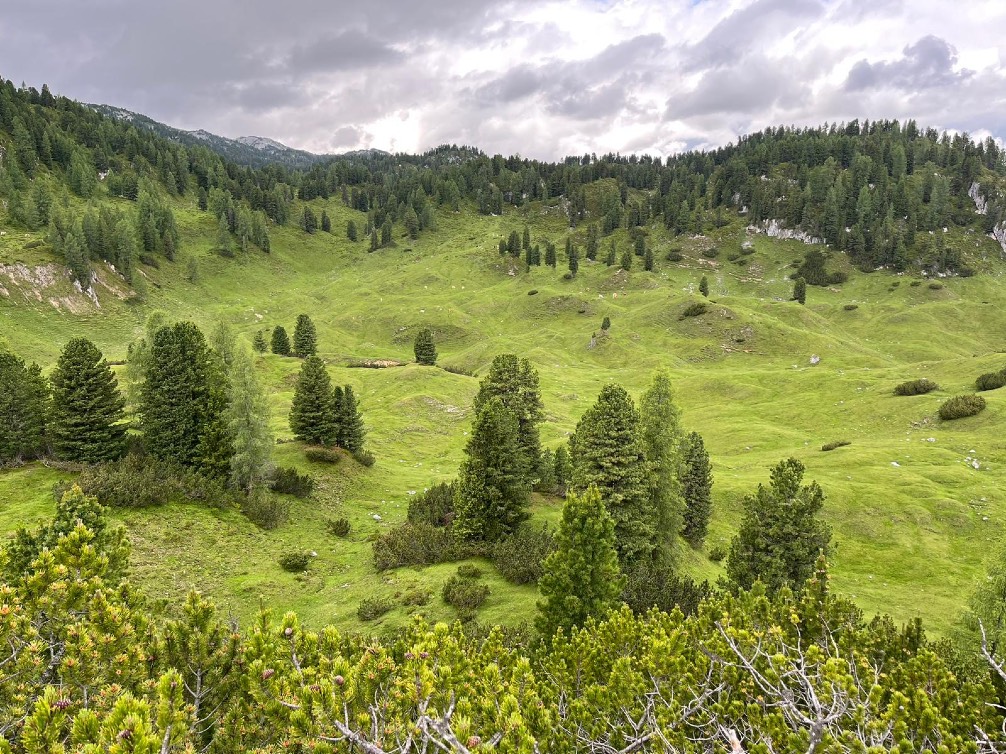
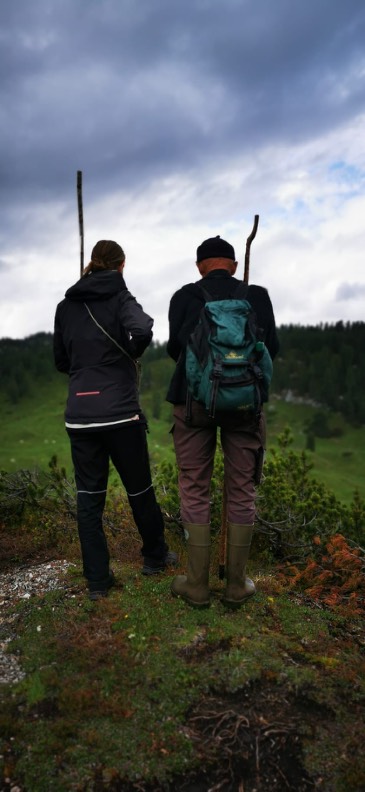 | 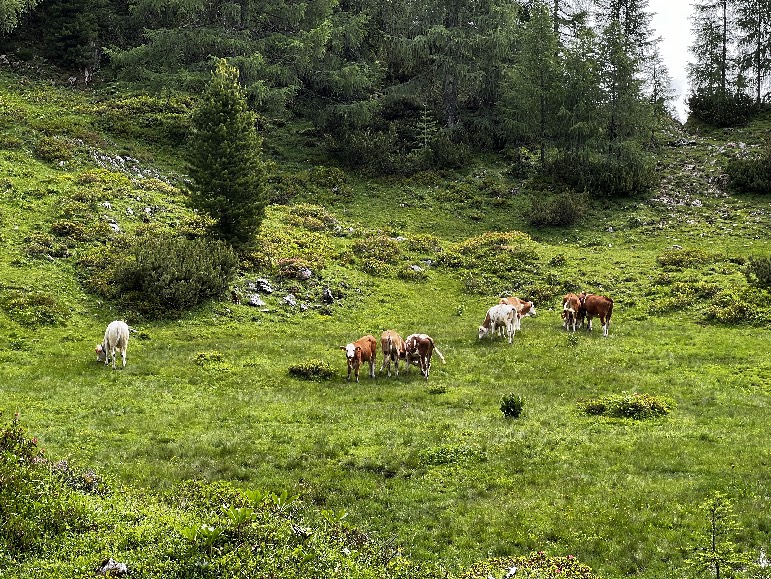 | And here he dwells. In a green, hilly sea, amongst the calming, asynchronous sounds of the bells around the necks of the cows and goats. After our initial encounter where we share our passion for the Danish author Inger Christensen and flutter hour hands in excitement, he offers us fresh, homemade goat cheese with pumpkin seed oil, and I’m in heaven. |
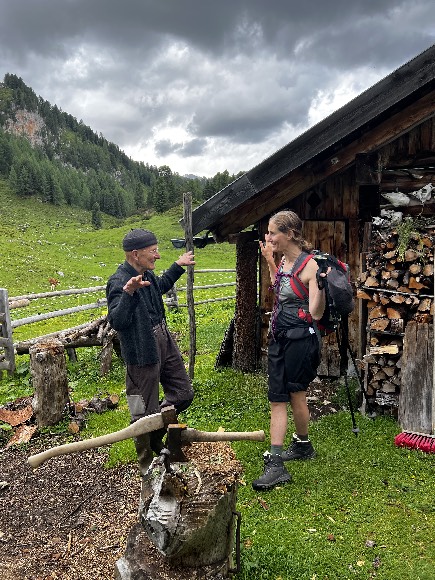 |  | |
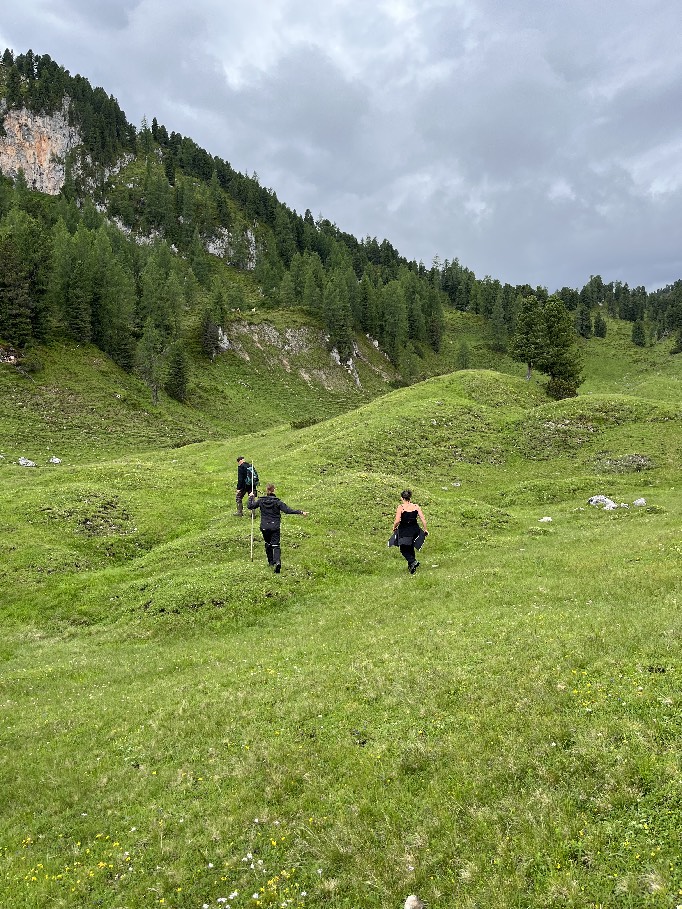 | 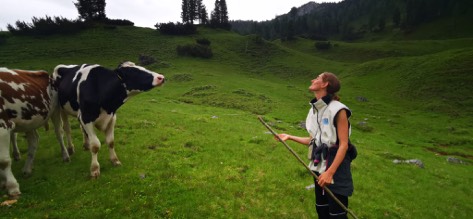 | |
After lunch we venture into the landscape with him. I borrow a long hiking stick like his and enjoy the exquisite challenge of following his nimble pace up and down the soft, green, yielding hills. His body was formed by this land. It knows it intimately and traverses it effortlessly. The stick feels almost like a paddle as I use it to stabilize my balance in the hilly, green sea. The day goes fast. As we head back to the house he continues far off the tend to a cow that was hurt on the journey up from the valley. I dance a final, thankful duet of goodbye with the rolling green hills and promise to return. Wir sehen uns. |  |
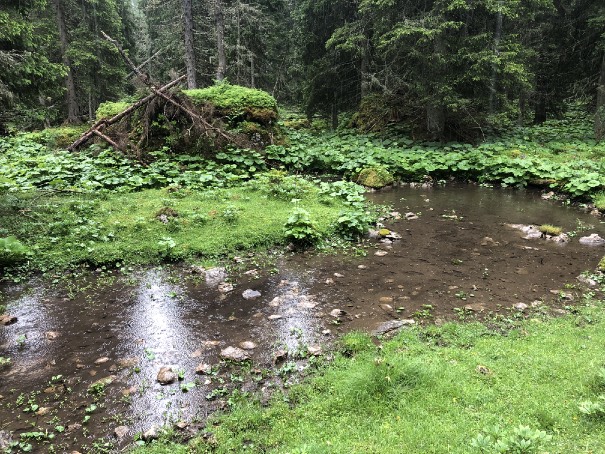 | And then we descent down, down, down, along with the waters from the sky that pour into the creeks and rivers and tumble down, like the water from my eyes, slipping unnoticed down my cheeks. | 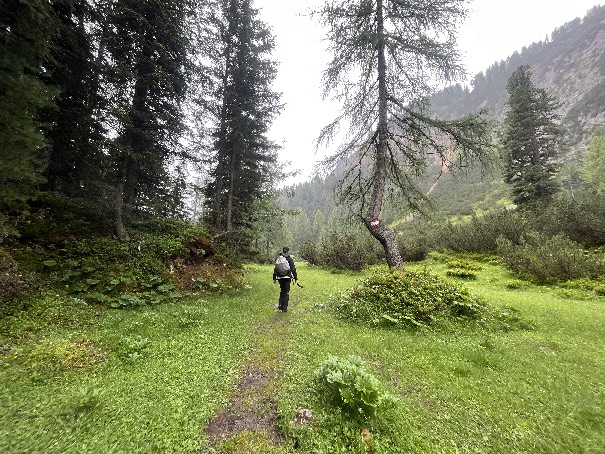 |
I want to dance with your melting, gushing, gurgling waters as they tumble exuberantly into the world and celebrate their emancipated form. I want to put my body to your giant glacial body and ingrain its presence in my flesh, to carry it with me long after it is no-longer there.I want to bring this mountain to people so they can feel these intimacies and resonances in their own bodies.


